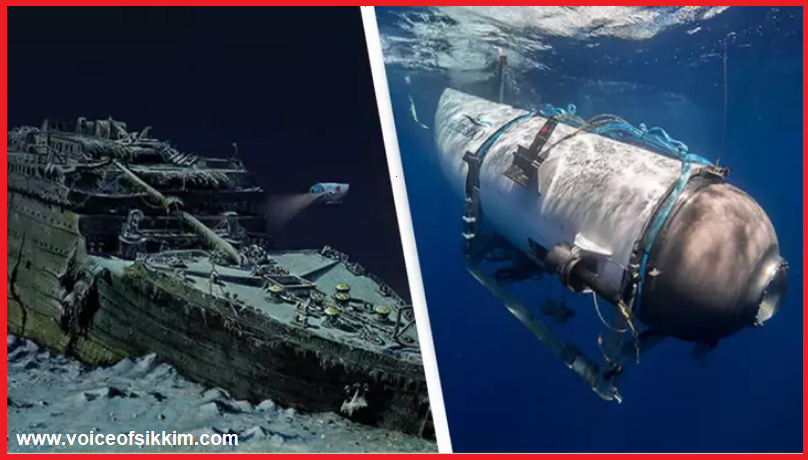
US Coast Guard has made a potential breakthrough in the urgent search for a missing submersible carrying five individuals near the Titanic wreckage. A significant development has occurred with the discovery of a debris field, intensifying the around-the-clock operation.
The US Coast Guard has achieved a potential breakthrough in the race against time to locate a missing submersible with five people on board, in close proximity to the remains of the Titanic. The discovery of a debris field is a crucial advancement in the operation, which is being conducted urgently and non-stop.
Although there is limited information available at present, authorities hold hope that the debris is associated with the Titan, the submersible that embarked on an expedition to explore the remnants of the renowned ocean liner. The search has now reached a critical stage, prompting heightened efforts through the deployment of undersea robots and advanced equipment. However, challenges persist in terms of pinpointing the submersible’s whereabouts and executing a safe rescue mission before oxygen supplies are depleted. Presented below are ten key developments in this gripping rescue endeavor.
The Titanic-bound submersible that went missing with five people on board suffered a “catastrophic implosion,” US Coast Guard Rear Adm. John Mauger said. https://t.co/vNlNH6yr0Y pic.twitter.com/449BJK2433
— CNN (@CNN) June 22, 2023
According to the Coast Guard’s confirmation on Thursday, the debris discovered approximately 1,600 feet from the front of the Titanic has been identified as belonging to the missing Titan submersible. This finding suggests that the submersible likely experienced a catastrophic implosion while descending towards the Titanic on Sunday.
Submersibles are specifically designed to withstand immense underwater pressures, such as those encountered at depths of 12,500 feet below the ocean’s surface. At such depths, the pressure is approximately 400 times greater than at sea level. However, if there is any damage or flaw in the vehicle’s hull, it can lead to a leak, which in turn triggers an immediate implosion due to the extreme pressures present, as reported by HITC.
Stefan Williams, a professor of marine robotics at the University of Sydney, defined to The Guardian that if the pressure vessel of the submersible failed catastrophically, it would resemble a small explosion. In such a scenario, there is a possibility that all safety mechanisms could be destroyed in the process.
Rescue operations have been underway since the submersible lost contact with the surface on Sunday. There were concerns that the five passengers aboard could be trapped alive inside the compact 21-foot-long vessel. However, with the discovery of debris and the likelihood of an implosion, it is presumed that the passengers did not endure prolonged suffering. Guillermo Söhnlein, one of the founders of OceanGate, stated to BBC that if an implosion occurred, it would have happened four days ago.
“Complete destruction would occur in 1/20th of a second, too fast to be cognitively recognized by the men within the submarine.”
Furthermore, according to the Journal of Physics: Conference Series, the implosion would have been nearly instantaneous, lasting only milliseconds. A similar incident took place in 1961 with the USS Thresher, a submarine that is believed to have experienced an implosion.
Debris Field Uncovered: The US Coast Guard announces the detection of a debris field near the Titanic, potentially linked to the missing submersible.
Uncertain Connection: Authorities have not yet confirmed the connection between the debris and the Titan, leading the investigation to continue.
Crucial 96-Hour Milestone: As the search surpasses the critical 96-hour mark, concerns arise regarding diminishing breathable air.
Intensive Rescue Operations: An expedited mobilization of ships, planes, and advanced equipment is underway at the site, with the aim of locating and rescuing the missing passengers.
Deployment of Underwater Robots: A Canadian ship and a French research institute contribute to the search effort by deploying undersea robots equipped with cameras, lights, and mechanical arms.
Expansion of Search Area: The search area extends to encompass thousands of miles in the deep waters, thereby intensifying the challenges of the mission.
Detection of Underwater Sounds: Coast Guard officials detect underwater sounds, providing hope for narrowing down the search area.
Measures to Conserve Oxygen: The survival prospects of the passengers depend on their ability to conserve breathable air inside the submersible.
Technical Challenges: Search and rescue teams face immense difficulties in locating the submersible in total darkness at great depths.
Risks of Deep-Sea Tourism: This incident underscores the hazards and uncertainties associated with deep-sea tourism, emphasizing the necessity for enhanced safety measures within the expanding industry.
As the search and rescue operation enters a critical phase, the hope of finding the missing passengers alive persists, while experts continue to grapple with the complexities of locating and retrieving the submersible. The world watches anxiously as authorities strive to bring a glimmer of hope to this challenging and high-stakes mission.






